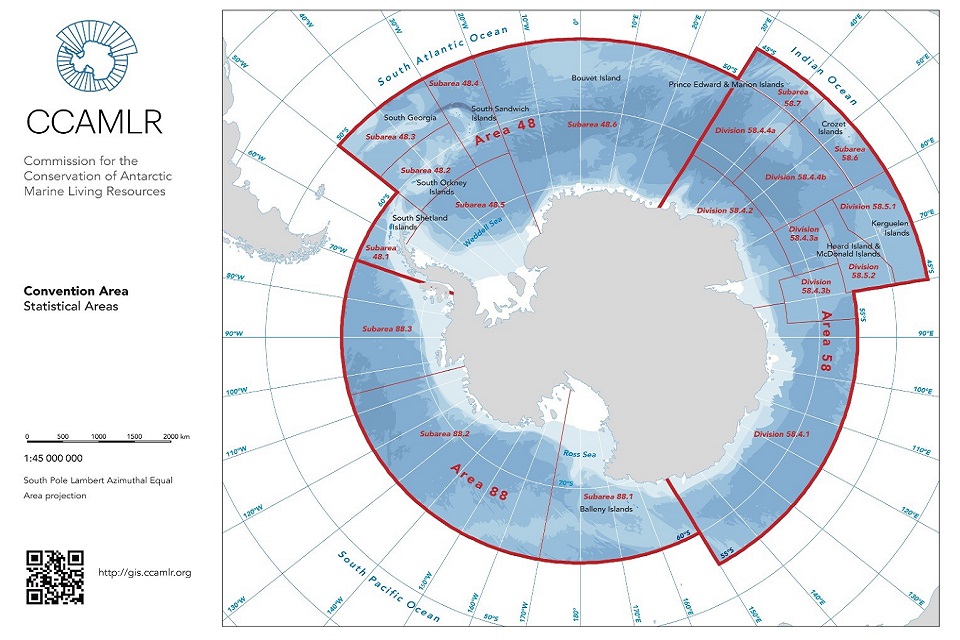As in previous years, members of the ACAP Secretariat last month attended as observers annual meetings of the Commission on the Conservation of Antarctic Marine Living Resources (CCAMLR) and its Scientific Committee, held last month in Hobart, Australia.
CCAMLR was established by international convention in 1982 with the objective of conserving Antarctic marine life. This was in response to increasing commercial interest in Antarctic krill resources, a keystone component of the Antarctic ecosystem and a history of over-exploitation of several other marine resources in the Southern Ocean (click here).

A paper presented to the 18th Meeting of the Scientific Committee’s Working Group on Fish Stock Assessment (WG-FSA) by the CCAMLR Secretariat (WG-FSA-18/13 Rev. 1), which met immediately prior to the Scientific Committee, noted that seabird bycatch levels registered during the last season were the lowest on record, a fact welcomed by the ACAP Observer. This is attributed in part to a significant decrease over the last decade in seabird bycatch observed within France’s Exclusive Economic Zone (EEZ) around its sub-Antarctic islands in the southern Indian Ocean.
Dr Marco Favero, ACAP Executive Secretary, presented a paper to the 37th Meeting of the Scientific Committee (SC-CCAMLR-XXXVII) that gave an update on the conservation status, distribution and priorities for albatrosses and petrels within the CCAMLR area.
The paper’s abstract follows:
“Thirteen ACAP species (out of 31 currently listed) are currently showing overall population declines. The population trends of a large proportion of 16 ACAP species with significant distribution in the CCAMLR area are still uncertain or showed declines during the last two decades, and two thirds of the total is listed by the IUCN as threatened. The greatest threat to the ACAP species is incidental mortality in longline and trawl fisheries. CCAMLR has achieved outstanding success in reducing seabird bycatch in the area under its jurisdiction to negligible levels. However, the species distributed in the Convention Area are highly migratory and largely extend their distribution in neighbouring waters, where bycatch is still occurring, both in jurisdictional waters as well as those administrated by RFMOs. Addressing the pervasive threat of fisheries bycatch for species as wide-ranging as albatrosses and petrels requires concerted and collaborative management actions covering both national and international waters. Bycatch of seabirds in adjacent regions may undermine the success that CCAMLR has achieved to date, and the conservation status of those species that breed or forage in the Convention Area is dependent on efforts to minimise bycatch both within the CCAMLR area, and importantly outside of it, both in jurisdictional waters and the high seas.”
In its preliminary report* the Scientific Committee noted ACAP’s paper and stated that it welcomed its ongoing collaboration with the Agreement. It also thanked the outgoing ACAP Executive Secretary, noting it was his last year in the position. Ms Christine Bogel, from New Zealand, takes up the role at month end (click here).
References**:
ACAP Secretariat 2018. Update on the conservation status, distribution and priorities for albatrosses and petrels in the CCAMLR area. SC-CAMLR-XXXVII/BG/010. 6 pp.
CCAMLR Secretariat 2018. Summary of incidental mortality associated with fishing activities collected in scientific observer and vessel data during the 2018 season. WG-FSA-18/13 Rev. 1. 8 pp.
*Reports of CCAMLR Scientific Committee annual meetings are made publicly available online once the text has been adopted by Parties inter-sessionally (click here).
**Papers submitted to CCAMLR meetings, including those to its Scientific Committee and working groups, are password-protected and are thus not publicly available.
John Cooper, ACAP Information Officer, 20 November 2018

 English
English  Français
Français  Español
Español